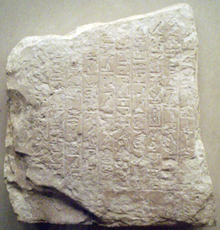
Back Decrets de Coptos Catalan Koptosdekrete German Decretos de Coptos Spanish Décrets de Coptos French Maklumat Coptos ID Koptoški odloki Slovenian

The Coptos Decrees are 18 complete or fragmentary ancient Egyptian royal decrees ranging from the 6th Dynasty (2345–2180 BC) to the late 8th Dynasty (c. 2170 BC). The decrees are numbered with letters of the Latin alphabet, starting with "Coptos Decree a" and ending with "Coptos Decree r". The earliest of the series were issued by Pepi I and Pepi II Neferkare to favor the clergy of the temple of Min,[1] while the others are datable to the reign of various kings of the 8th Dynasty, and concern various favors granted to an important official from Coptos named Shemay and to his family members.[2] The decrees reflect the waning of the power of the pharaoh in the early First Intermediate Period.[3]
The Coptos decrees should not be confused with the Coptos Decree of Nubkheperre Intef, a unique document datable to the much later 17th Dynasty.
- ^ Alan Gardiner, Egypt of the Pharaohs: an introduction, Oxford University Press, 1964, p. 108; quote: "But perhaps the most persuasive evidence of their short-lived domination is offered by some inscriptions discovered by Raymond Weill at Coptos in 1910-11. Under the ruins of a structure of Roman date were found carefully stowed away a number of decrees carved in hieroglyphic on slabs of limestone, some dating from the reign of Pepy II, and most of them designed to protect the temple of Min and its priesthood from interference and the corvee. But among them as many as eight were apparently dispatched on the same day in the first year of a King Neferkare, the last king but one in the series of the Abydos list. The addressee was in each case the vizier Shemai and each royal command was concerned either with him or some member of his family. One of the decrees confirmed him in his vizierate in all the twenty-two nomes of Upper Egypt, while another recorded the appointment of his son Idi to the post of Governor of Upper Egypt in the seven southernmost nomes. A third decree grants precedence over all other women to Shemai's wife Nebye, who is described as a 'King's eldest daughter', and perhaps even more remarkable is a fourth making elaborate arrangements for the funerary cult of both husband and wife in all the temples of the land. There is no hint of unrest or political disturbance in any of these texts, though we may possibly read into them a desperate anxiety on the king's part to conciliate one specially powerful Upper Egyptian magnate."
- ^ Toby Wilkinson, The Rise and Fall of Ancient Egypt: The History of a Civilisation from 3000BC to Cleopatra, London, Bloomsbury, 2010, ISBN 978-0-7475-9949-4, pp. 121–22.
- ^ Cite error: The named reference
hayeswas invoked but never defined (see the help page).